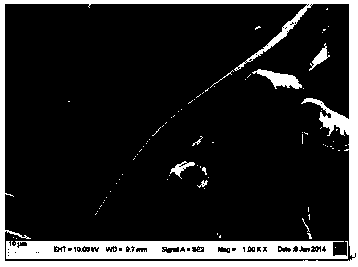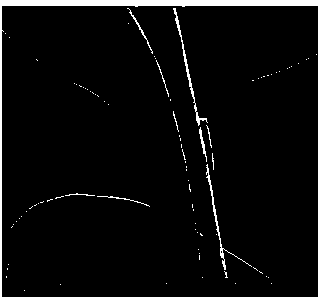Method for recycling waste dust removal filter material
A filter material and composite filter material technology, applied in the field of recycling waste dust removal filter material, can solve the problems of ineffective utilization of resources, secondary pollution, etc., and achieve environmental protection, low cost, and wide application prospects. Effect
- Summary
- Abstract
- Description
- Claims
- Application Information
AI Technical Summary
Problems solved by technology
Method used
Image
Examples
Embodiment 1
[0033] (1) Decontaminate and clean the waste dust-removing aramid filter material. After drying, first put it in an inert gas N 2 Carbonized at 800 °C for 60 min under the protection, and then used KOH in N according to the ratio of alkali to carbon mass ratio of 4:1. 2 Activated at 800 °C for 60 min under protection, the specific surface area was as high as 2493.049 m 2 / g of aramid filter material-based activated carbon fiber (ACF);
[0034] (2) The ACF in (1) was treated with 30 wt% nitric acid solution for 120 min, filtered with suction, washed with deionized water to make the pH value neutral, and dried in an oven for 12 h;
[0035] (3) Take 0.3 g of acidified ACF in (2), prepare 3.0 g of manganese acetate ethanol solution with a mass concentration of 2.86 % at the same time, and use incipient wetness dipping method to make ACF immersed in saturated manganese acetate ethanol solution (≈0.66 g) , after dipping at room temperature for 12-24 h, and drying in an oven for 12...
Embodiment 2
[0041] (1) Decontaminate and clean the waste dust-removing aramid filter material. After drying, first put it in an inert gas N 2 Carbonized at 700 °C for 120 min under the protection, and then used KOH in N according to the ratio of alkali to carbon mass ratio of 4:1. 2Activated at 800 °C for 60 min under protection, the specific surface area was as high as 2493.049 m 2 / g of aramid filter material-based activated carbon fiber (ACF);
[0042] (2) The ACF in (1) was treated with 60 wt% nitric acid solution for 60 min, filtered with suction, washed with deionized water to make the pH value close to neutral, and dried in an oven for 18 h;
[0043] (3) Take 0.3 g of acidified ACF in (2), and prepare 3.0 g of manganese acetate ethanol solution with a mass concentration of 8.38% at the same time, and use incipient wetness impregnation method to impregnate ACF with saturated manganese acetate ethanol solution (≈0.66 g) , after immersion at room temperature for 18 h, and dried in a...
Embodiment 3
[0049] (1) Decontaminate and clean the waste dust-removing aramid filter material. After drying, first put it in an inert gas N 2 Carbonized at 880 °C for 60 min under the protection, and then used KOH in the ratio of alkali to carbon mass ratio of 4:1 in N 2 Activated at 900 °C for 30 min under protection, the specific surface area was as high as 2493.049 m 2 / g of aramid filter material-based activated carbon fiber (ACF);
[0050] (2) The ACF in (1) was treated with 30 wt% nitric acid solution for 120 min, filtered with suction, washed with deionized water to make the pH value close to neutral, and dried in an oven for 24 h;
[0051] (3) Take 0.3 g of acidified ACF in (2), prepare 3.0 g of manganese acetate ethanol solution with a mass concentration of 16.6% at the same time, and use incipient wetness impregnation method to impregnate ACF with saturated manganese acetate ethanol solution (≈0.66 g) , after dipping at room temperature for 24 h, and drying in an oven for 24 h...
PUM
| Property | Measurement | Unit |
|---|---|---|
| Average pore size | aaaaa | aaaaa |
| Specific surface area | aaaaa | aaaaa |
Abstract
Description
Claims
Application Information
 Login to View More
Login to View More - R&D
- Intellectual Property
- Life Sciences
- Materials
- Tech Scout
- Unparalleled Data Quality
- Higher Quality Content
- 60% Fewer Hallucinations
Browse by: Latest US Patents, China's latest patents, Technical Efficacy Thesaurus, Application Domain, Technology Topic, Popular Technical Reports.
© 2025 PatSnap. All rights reserved.Legal|Privacy policy|Modern Slavery Act Transparency Statement|Sitemap|About US| Contact US: help@patsnap.com



